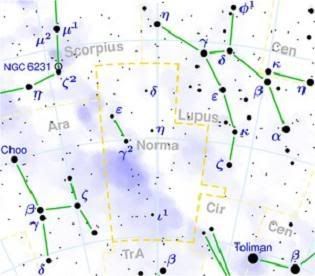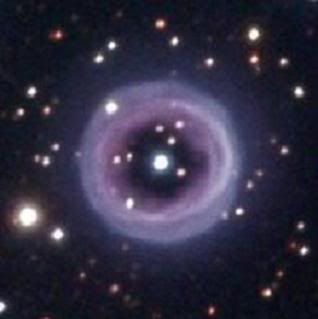Post by glactus on Feb 17, 2008 7:09:11 GMT

Norma is a quite small constellation of the southern hemisphere belonging to the La Caille constellation family. It lies north of Triangulum Australe and west of Ara. In the north Norma is surrounded by Lupus and Scorpius. The Milky Way still runs brilliant through this constellation. The orginal boundaries have been changed since its stars first have been delineated to form a star group. The constellation represents a scientific instrument, "the level". The original name was Norma et Regula (the level and the square). There are interesting objects to view in this constellaion including the stunning Ant nebula, one of the most beautuful of all nebulae in the heavens.
Notable stars:
Double stars Gamma Normae
The double gamma1/gamma2 Normae is a visual binary. The two unrelated stars are a F9 supergiant of 4.99 magnitude and a G8 giant with 4.02 magnitude. Distance from Earth is 1,440 light years for gamma 1 and 128 light years for gamma 2.
Epsilon Normae
With a small telescope the 8th mag companion of the B4 main sequence star epsilon Normae can be seen. With the large telescopes of the observatories both stars are revealed to be spectroscopic binaries (they are too close to be split in a telescope but their spectra show the existence of an second component). So this is actually a four star system. Distance from Earth is 600 light years.
Iota 1 Normae
A small telescope is sufficient to resolve the A7 subgiant iota Normae of 4.63 mag and its 8th mag companion (separation 11"). With a telescope of at least 200mm aperture iota 1 Nor can be split into a pair of stars. They revolve each other with a period of 26 years. Distance from Earth is 271 light years.
S Nor
The Cepheid variable star S Normae (spectraltype F8-G0Ib; 6.49 mag) is one of the 35 stars building the open star cluster NGC 6087, which is a good object for binoculars. Distance from Earth is 3,500 light years.
Notable objects:

Mz 3 The Ant Nebula
The Ant Nebula, whose technical name is Mz3, resembles the head and thorax of an ant when observed with ground-based telescopes. The new Hubble image shows the "ant's" body being cast off by a star similar to our Sun, and as a pair of fiery lobes protruding from this dying star. The Ant Nebula is located between 3,000 and 6,000 light years from Earth. Apparent magnitude is 7.9.

Sp-1 (Shapely 1, or Fine Ring Nebula)
The Fine Ring Nebula is an unusual annular planetary. The nebula itself appears quite small at a little over an arc minute in diameter, while its central star is a magnitude 14 white dwarf. This object is unusual because those planetaries that are not bipolar are more or less spherical shells of material thrown off by the central star as it undergoes an internal rearrangement. We often see them as thick annuli because we look through a greater thickness at the edge of the shell. However, Shapley 1 seems to be a true torus, a doughnut-shaped ring of material that we happen to see face-on around the central star. Sp-1 is about 1000 light years distant, and magnitude is 12.1

NGC 6165
Emission nebula NGC 6164-5 is a rectangular, bipolar cloud with rounded corners and a diagonal bar producing an inverted S-shaped appearance. The nebula measures about 4.2 light-years across, and contains gases ejected by the star HD 148937 (6.8 magnitude) at its heart. This star is 40 times more massive than the Sun, and at about three to four million years of age, is past the middle of its life span and aging fast. It will likely end its life in a violent supernova explosion. Distance from Earth is 4,200 light years.

credits:
Norma map: Wikipedia
en.wikipedia.org/wiki/Norma_(constellation)
image: Ant Nebula: crying voice.com:http://www.cryingvoice.com/Evolution/gifs/hst_nebula_ant.jpg
mage: Sp-1 (Shapley1) astrosurf.com
www.astrosurf.com/antilhue/shapley1.htm
image: NGC 6165: capella
www.capella observatory.com/DiffuseNebula.htm


